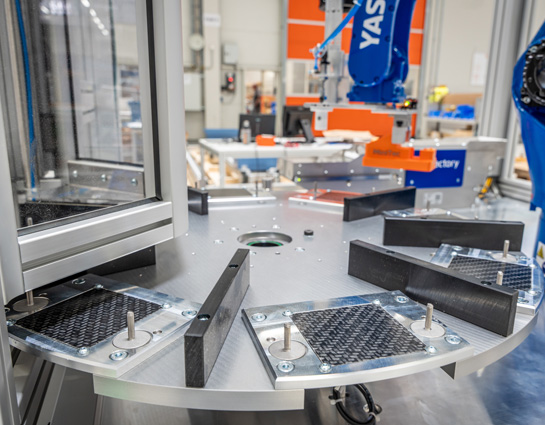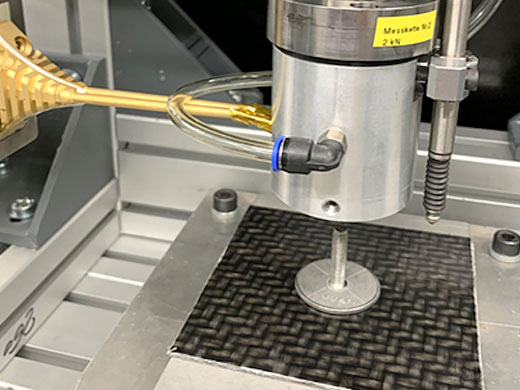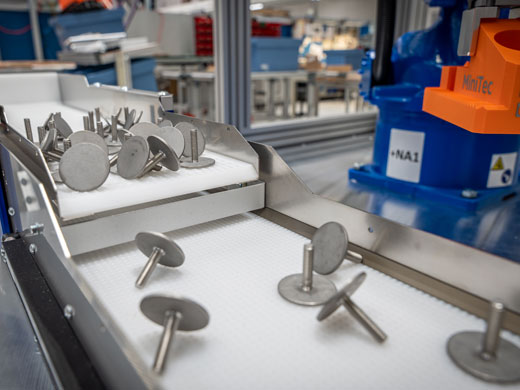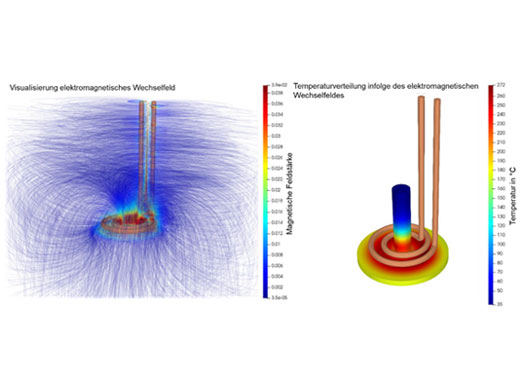- Products
- Solutions
- Service
- Company
The future of joining was the subject of a research project with MiniTec and several partners. The efficient joining of metal fastening elements to thermoplastics offers many advantages that can now be put into practice.
Joints between metal and thermoplastic fiber-reinforced plastic composites (TP-FRP) are highly relevant in numerous applications in industry, mobility and sport. To make efficient use of the inherent properties of these materials, advanced joining techniques and optimized joining approaches are required.
joining approaches are necessary. In contrast to techniques such as drilling or clinching, material bonding thermal joining allows a connection to the TPFRP without damaging the fibers. For example, a screw connection on the fastening elements is used to integrate the TP-FRP lightweight structure with the thermally joined fastening elements into a higher-level assembly. In this way, extraordinary strength can be achieved within a few seconds in a fully automated process environment. Another advantage is that the fastening elements can be can be easily removed from the TP-FKV by heating and reattached if required. This is particularly advantageous for recycling and repair.

Fully automated manufacturing cell

Lab-Scale-End-Effector
Combination of established technologies
A unique, innovative, industry-oriented research project was created by combining decades of established technologies that previously had nothing in common. The starting point for the so-called HyBe project (Automated Hybrid Joining Technology for joining metal fastening elements to TP-FRP) and the new joining technology is the combination of adhesive systems from continuous coil coating with metallic fastening elements, (fiber-reinforced) thermoplastics and induction welding.
In continuous (metal) strip coating (also known as coil coating), metallic strips, known as coils, are coated with an organic coating. This is done using a continuous process for coating one or both sides of steel or aluminum sheets. The resulting material is a composite of a metallic carrier material and an organic coating. Common coating materials are (colored) paints, plastic powders, functional coatings and plastic films. For the latter two, adhesive systems are used to permanently bond the plastics to the metal.
The reactive coatings can be stored for twelve months or more before joining with plastics. In coil coating, kilometers of metal strips are continuously coated using industrial systems that fill the entire hall - the adhesive systems optimized for this process can be used very efficiently and effectively here. However, there have been no other applications for these adhesives to date, as special parameters are required for the application and curing process.
Permanent connection
For metallic fastening elements such as screws, bolts, bushes or other anchoring systems, a permanent bond can already be created with almost any material using a wide range of technologies without welding, drilling or screwing. Single or multi-component, pasty or liquid, inert or reactive adhesives are currently used for this purpose.
The adhesives are either mixed and applied by the user, which requires the correct handling of the adhesives (possibly hazardous goods) and the appropriate equipment for mixing and application on the user's side. Alternatively, the adhesive is already pre-applied to the metallic elements and must be cooled along the supply chain and in the warehouse before the very limited shelf life is reached.

Joined fastener
Lightweight and easy to recycle
Fiber-reinforced thermoplastics (TP-FRP; fiber-plastic composites) are characterized not only by their fast processability and low weight, but also by their good recyclability, making them an important alternative to thermoset FRP. These properties qualify TP-FRP for a large number of lightweight construction applications, including in the automotive industry. One way of optimizing the properties of TP-FRP components in terms of application technology is to combine them with metals. For example, metallic force introduction elements can be used in TP-FRP components through the use of suitable hybrid joining processes. Hybrid joints in particular, which allow homogeneous force application, lead to greater overall stability of the component, which in turn can reduce the overall weight as a result of synergy effects.

Visualization of the electromagnetic alternating field and the temperature distribution due to the electromagnetic alternating field
Induction welding or sealing processes
Induction welding or sealing is a form of welding in which electromagnetic induction is used to heat the workpiece in a controlled and precise manner. A high-frequency electromagnetic field is generated by means of an induction coil, which is supplied with high-frequency and possibly pulsed current and acts on an electrically conductive or ferromagnetic workpiece. In an electrically conductive workpiece, the main heating effect is resistance heating, which is based on induced currents, so-called eddy currents.
For inductive welding or sealing processes, inductive heating offers great advantages over non-electrical methods - the energy is only introduced into the conductive layer or the conductive component; and only there is the required process heat generated. This means that potentially disruptive thermal effects in surrounding and adjacent materials can be avoided. At the same time, the energy is dosed in a controlled manner, which means that no excess residual heat can have a negative effect on the component even after the actual sealing process.
Project partners and project objective
The HyBe project was a research project dedicated to the development of a fully automated joining process for the fast and quality-assured joining of metallic fastening elements to TP-FRP components. The four key technologies mentioned above were combined for this were combined. The aim of the project was to develop an enabling technology that allows automated, digitalized and energy-efficient inductive hybrid joining. In addition to process development, the characterization of the hybrid joints based on material examples and studies on long-term durability also played an important role in the HyBe project.
Over the course of the project, the process time, energy input and adhesives were further optimized. The close cooperation between the project partners IVW, MiniTec, Himmelwerk and H.B. Fuller/Kömmerling resulted in a new type of hybrid joining process that can be used across all industries. The conceivable areas of application are diverse and range from production cells to automation solutions in general and robots directly on assembly lines to joints in ship hulls.
The project “Automated hybrid welding of metallic fastening elements on fiber-plastic composite components (HyBe)” was funded by the Central Innovation Program for SMEs (ZIM) of the Federal Ministry of Economics and Climate Protection (BMWK) - R&D cooperation projects, funding code: KK5003706FF1.

Do you need a suitable solution or an approach for your project? Then please contact us!